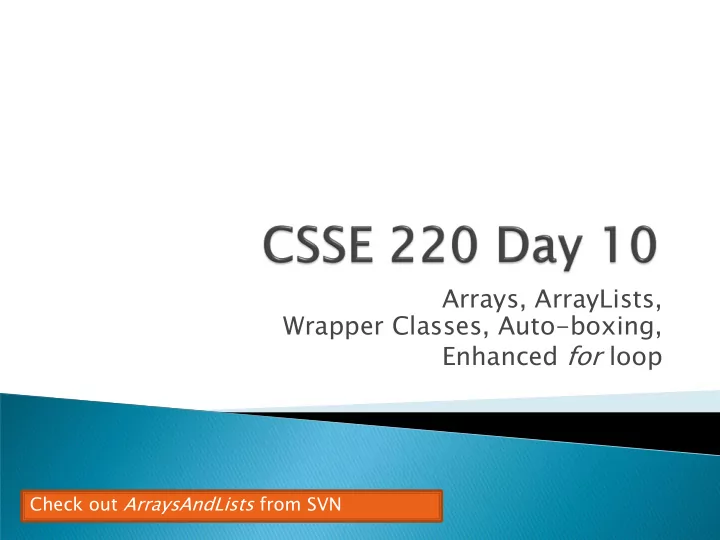

Arrays, ArrayLists, Wrapper Classes, Auto-boxing, Enhanced for loop Check out ArraysAndLists from SVN
See the Schedule page, Session 12, for a link to a document that lists the topics covered by this exam Test next Monday ◦ Evening exam! Schedule page says where and when. ◦ Exam is 7-9 p.m. but you may start the exam up to 1 hour early and stay up to 1 hour late (or both) Topics from Chapters 1-7 Will include: ◦ A closed-book paper part: short answer, fill-in-the-blank, trace- code-by-hand, draw box-and-pointer diagrams, find-errors-in- code, write short chunks of code We will list in advance ALL the possible topics for this portion of the exam ◦ A programming part: a few small programs, unit tests provided for some of them, you write unit tests for others Review in class Thursday ◦ Bring questions ◦ I won’t prepare anything but am happy to cover whatever you want, including working examples Q1
What it is for: Bundling a collection of objects under a single name, With elements in the collection referred to by their index in the collection (0, 1, 2, …) Syntax for declaring: ElementType [] name Examples: ◦ A local variable: double[] averages; ◦ Parameters: public int max(int[] values) {…} ◦ A field: private Investment[] mutualFunds;
Syntax for allocating: new ElementType [ length ] Creates space to hold values Sets values to defaults Don’t forget this step! ◦ 0 for number types ◦ false for boolean type ◦ null for object types This does NOT construct any Examples: Dog’s. It just ◦ double[] polls = new double[50]; allocates space for referring to Dog’s ◦ int[] elecVotes = new int[50]; (all the Dog’s start ◦ Dog[] dogs = new Dog[50]; out as null ) Q2
Reading: ◦ double exp = polls[42] * elecVotes[42]; Reads the element Sets the value with index 42. in slot 37. Writing: ◦ elecVotes[37] = 11; Index numbers run from 0 to array length – 1 Getting array length: elecVotes.length No parentheses, array Q3,4 length is (like) a field
Arrays… Java C Pytho hon have fixed length yes yes no are initialized to default yes no n/a values track their own length yes no yes trying to access ―out of yes no yes bounds‖ stops program before worse things happen
Begin the ElectionSimulator program (in ArraysAndLists), per the instructions in Homework 10 Your instructor will demo a run of the program. Here is a UML class diagram for it. You might find the Summary on Arrays and ArrayList’s helpful.
ArrayLists to the rescue Example: Element type ◦ ArrayList<State> states = new ArrayList<State>(); Variable type Constructs new, Adds new element empty list to end of list states.add (new State(“Indiana”, 11, .484, .497)); ArrayList is a generic class ◦ Type in <brackets> is called a type parameter Q5,6
Type parameter can’t be a primitive type ◦ Not: ArrayList<int> runs; ◦ But: ArrayList<Integer> runs; Use get get method to read elements ◦ Not: runs[12] ◦ But: runs.get(12) Use size() not length ◦ Not: runs.length ◦ But: runs.size()
Add to end: ◦ victories.add(new WorldSeries(2008)); Overwrite existing element: ◦ victories.set(0,new WorldSeries(1907)); Insert in the middle: ◦ victories.add(1, new WorldSeries(1908)); ◦ Pushes elements at indexes 2 and higher up one Can also remove: ◦ victories.remove(victories.size() - 1)
Continue the ElectionSimulator program (in ArraysAndLists), per the instructions in Homework 10 Your instructor will demo a run of the program. Here is a UML class diagram for it. You might find the Summary on Arrays and ArrayList’s helpful.
IT’S ALL REAL!
Problem: Primitive ve Wrapper ◦ ArrayList’s only hold objects byte Byte ◦ Primitive types aren’t objects boolean Boolean char Character Solution: double Double ◦ Wrapper classes — instances are float Float used to ―turn‖ primitive types int Integer into objects long Long ◦ Primitive value is stored in a short Short field inside the object Q7
Auto-boxing: automatically enclosing a primitive type in a wrapper object when needed Example: ◦ You write: Integer m = 6; ◦ Java does: Integer m = new Integer(6); ◦ You write: Integer answer = m * 7; ◦ Java does: int temp = m.intValue() * 7; Integer answer = new Integer(temp);
Just have to remember to use wrapper class for list element type Example: ◦ ArrayList<Integer> runs = new ArrayList<Integer>(); runs.add(9); // 9 is auto-boxed ◦ int r = runs.get(0); // result is unboxed
Old school double scores[] = … double sum = 0.0; for (int i=0; i < scores.length; i++) { sum += scores[i]; } New, whiz-bang, enhanced for loop No index double scores[] = … variable (easy, , double sum = 0.0; but limit ited ed in 2 for (double score : scores) { respec ects) s) sum += score; Gives a name } ( score here) to each element Say ―in‖
ArrayList <State> states = … int total = 0; for (State state : states) { total += state.getElectoralVotes(); } Q8
Continue (and strive to finish) TONIGHT, do the short the ElectionSimulator program Survey for assigning (in ArraysAndLists), per the partners for the Game of instructions in Homework 10 Life exercise on Angel, under Lessons ~ Assessments Your instructor will demo a (at the top, first item listed) run of the program. Here is a UML class diagram for it. You might find the Summary on Arrays and ArrayList’s helpful.
Recommend
More recommend